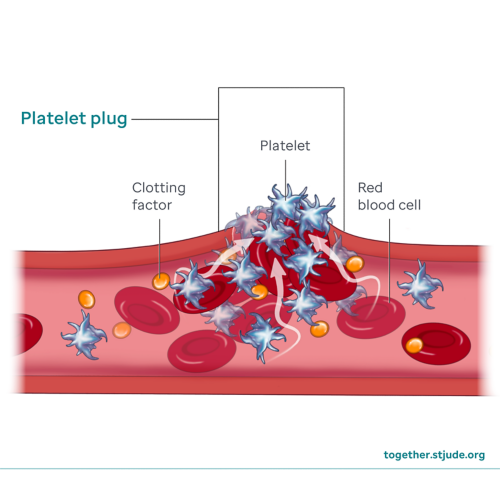What is von Willebrand disease?
Von Willebrand disease (VWD) is a genetic bleeding disorder that affects the blood’s ability to form clots. A person with von Willebrand disease may have increased bruising, prolonged nosebleeds, mouth bleeds, heavy menstrual periods, or heavy bleeding that’s hard to stop after an injury or procedure.
Blood cells called platelets need proteins called clotting factors to help clot the blood. One of these proteins is called von Willebrand factor. It helps platelets stick together to form a strong blood clot to stop bleeding. Von Willebrand factor is also bound to clotting factor VIII (8), another important protein in blood that helps it to clot.
In von Willebrand disease, a person either has low levels of von Willebrand factor or the factor does not work well. There are 3 main types of von Willebrand disease: Types 1, 2, and 3. People with type 1 or type 2 von Willebrand disease might not have many bleeding problems. Type 3 von Willebrand disease is more severe.
Treatments include desmopressin acetate, factor replacement therapy, and medicines to help blood clot.
Symptoms of von Willebrand disease
The signs and symptoms depend on the type of von Willebrand disease a person has and how severe the disorder is.
With type 1 or type 2 von Willebrand disease, a person may have signs and symptoms of mild-to-moderate bleeding:
- Frequent bruising from minor bumps or injuries
- Large bruises or bruises you can feel
- Heavy bleeding after a cut or other injury
- Heavy bleeding after surgery
- Frequent nosebleeds that are hard to stop
- Prolonged gum bleeding after teeth brushing or a dental procedure
- Prolonged menstrual bleeding (periods)
- Blood in the stools from bleeding in the stomach or intestines
- Blood in the urine from bleeding in the bladder or kidneys
In addition to mild-to-moderate bleeding, a person with type 3 von Willebrand disease may also have the following:
- Unexplained episodes of severe bleeding that can be life threatening if not treated right away
- Bleeding into joints and muscles, which can cause severe pain and swelling
In women, heavy menstrual bleeding is often the main sign of von Willebrand disease. However, a woman with heavy periods does not always have the disorder.
Causes of von Willebrand disease
Von Willebrand disease is usually an inherited disorder, which means it is passed on from parent to child through a specific gene change (mutation). It is the most common inherited bleeding disorder.
Type 1 and some Type 2 subtypes can be passed on by only 1 parent. Type 3 and Type 2N von Willebrand disease only occur if a child gets the gene from both parents. If a person has the gene, they can still pass the gene on to a child even if they have no signs or symptoms of bleeding problems.
Sometimes a person is not born with von Willebrand disease but develops it later in life. In this case, the person has acquired von Willebrand syndrome, which can occur as a result of other health problems.
Types of von Willebrand disease
There are 3 main types of von Willebrand disease:
- Type 1: A person with type 1 von Willebrand disease has low levels of von Willebrand factor and may also have low levels of clotting factor VIII (8). This is the most common form of von Willebrand disease. About 3 out of 4 people with von Willebrand disease have type 1.
- Type 2: A person with type 2 von Willebrand disease has von Willebrand factor that does not work well. This type has subtypes including 2A, 2B, 2M, and 2N. Some subtypes have mild bleeding, and some are more severe.
- Type 3: A person with type 3 von Willebrand disease often has no von Willebrand factor at all along with low levels of clotting factor VIII (8). Although it is rare, this is the most severe form of von Willebrand disease.
Diagnosis of von Willebrand disease
Von Willebrand disease can be hard to diagnose. People with type 1 or type 2 von Willebrand disease might not have many bleeding problems. They might not be diagnosed with the disorder unless they have heavy menstrual cycles or hard-to-stop bleeding after injury or surgery.
On the other hand, type 3 von Willebrand disease can cause major bleeding problems during infancy and childhood. Babies born with this serious form of the disorder are usually diagnosed early in life.
Von Willebrand disease is diagnosed based on your child’s medical history, physical exam, and lab tests. Your doctor may ask you about any changes in bleeding or bruising, recent illnesses, or medicines your child is taking.
Lab tests may include:
- Complete blood count (CBC) to measure the number and size of the blood cells
- Platelet aggregation tests to measure how well the platelets stick together to form clots
- Activated partial thromboplastin time test (APTT) to measure how long it takes blood to clot
- Von Willebrand factor antigen and multimers tests to measure the amount and structure of von Willebrand factor in the blood
- Blood tests to measure Factor VIII and Von Willebrand factor activity
Your care team may do other blood tests to measure the activity of Von Willebrand factor and other clotting factors and to see how long it takes blood clots to form.
Treatments for von Willebrand disease
Treatment for von Willebrand disease is based on how severe the disorder is. Most people have type 1 von Willebrand disease, the mildest form of the disorder. If your child has type 1, they may only need treatment if they have surgery, a dental procedure, or a traumatic injury. If your child has a more severe form of von Willebrand disease, they may need treatment more often to prevent or stop life-threatening bleeds.
Current therapies include:
Desmopressin acetate (DDVAP)
- DDVAP is a medicine that causes the release of more von Willebrand factor into the blood.
- The von Willebrand factor is stored in the lining of the blood vessels and in platelets. DDAVP is a man-made hormone that stimulates the release of the factor from its stores. This increases the amount available in the blood.
- DDVAP is an effective treatment for most people with type 1 von Willebrand disease and for some people with type 2 von Willebrand disease.
- Treatment with DDAVP is only given in certain situations, such as before a dental procedure to help reduce or prevent bleeding. If used often, this medicine will not work as well.
DDAVP challenge: Some people do not have a good increase in their factor levels with DDAVP. To see if your child will have a good response, your care team may order a DDAVP challenge. This will measure the amount of von Willebrand factor in the blood before and after the medicine is given.
Von Willebrand factor replacement therapy
- This treatment replaces the clotting factor that is low or missing in the blood. Because the von Willebrand factor works better when bound to factor VIII (8), von Willebrand factor products have both proteins.
- This treatment may be used if a person cannot tolerate DDAVP, has type 1 von Willebrand disease that does not respond to DDAVP, or has type 2 or type 3 von Willebrand disease.
- Von Willebrand factor products include Humate-P®, Alphanate®, VONVENDI®, and Wilate®.
- Replacement therapy is given in a vein by IV at a medical clinic or at home.
Antifibrinolytic medicines
- Antifibrinolytic medicines are used to help keep blood clots together once they are formed.
- These medicines can be used alone or along with DDVAP and von Willebrand factor replacement therapy.
- Examples of antifibrinolytic medicines are aminocaproic acid (Amicar®) and tranexamic acid (Lysteda®).
- Antifibrinolytic medicines are usually taken before and after a dental procedure. They are also used to stop bleeding from the mouth or nose or to treat heavy menstrual cycles.
Fibrin glue
- Fibrin glue (also called fibrin sealant) is a medicine applied directly to a wound to stop bleeding by creating a clot.
- Fibrin is a type of protein that works to hold blood clots together.
- Clotting factors use fibrin to help create a strong seal over a wound.
- Fibrin glue may sometimes be used along with clotting factor replacement therapy, an antifibrinolytic medicine, or DDAVP.
Living with von Willebrand disease
Von Willebrand disease is most often a mild disorder. Children with milder forms of Von Willebrand disease generally have fewer bleeding symptoms and need less intensive treatment. Those with severe disease may be at higher risk for spontaneous or severe bleeding episodes.
Complications of von Willebrand disease can include joint bleeds, iron deficiency anemia, or serious bleeding events. It is important to work with your care team to make a treatment and monitoring plan that is right for your child.
Take steps to help keep your child safe and reduce the risk of problems. These include:
- Do not give your child medicines without talking to your health care provider or pharmacist. This includes non-prescription medicines, such as aspirin. Some medicines can increase the risk of bleeding.
- Avoid sports and activities that put your child at higher risk for injury. Be sure your child takes precautions like wearing protective gear and seat belts.
- Tell all health care providers about your child’s condition, especially before any surgery or dental procedure.
Call your doctor or go to an emergency room right away if your child has any serious injury, especially one that involves any hit to the head or stomach or bleeding that does not stop.
Genetic counseling may be helpful to people with a family history of von Willebrand disease who plan to have children.
With proper medical care, most children with von Willebrand disease—including type 3—can live a normal, active life.
Questions to ask your care team



